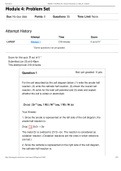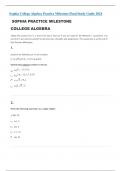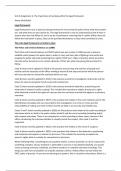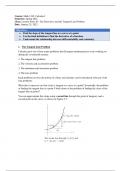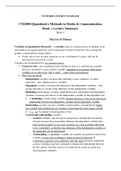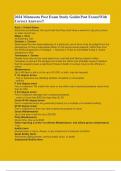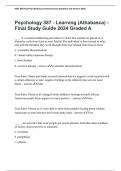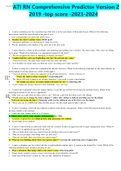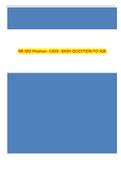6/25/2021 Module 4: Problem Set: General Chemistry 2 with Lab- Schiren
Module 4: Problem Set
Due No due date Points 0 Questions 35 Time Limit None
Attempt History
Attempt Time Score
LATEST Attempt 1 218 minutes 0 out of 0 *
* Some questions not yet graded
Score for this quiz: 0 out of 0 *
Submitted Jun 25 at 6:40pm
This attempt took 218 minutes.
Question 1 Not yet graded / 0 pts
For the cell described by the cell diagram below: (1) write the anode half
reaction, (2) write the cathode half reaction, (3) shown the overall cell
reaction, (4) solve for the total cell potential and (5) state and explain
whether the cell is voltaic or electrolytic.
Zn (s) | Zn+2 (aq, 1 M) || Ni+2 (aq, 1 M) | Ni (s)
Your Answer:
1. Since the anode is represented on the left side of the cell diagram, the
anode half reaction is:
Zn(s) Zn2+ + 2e-
The metal Zn is oxidized to Zn^2+ ion. The reaction is considered as
oxidation reaction. (Oxidation reactions are the ones in which electrons
are lost.)
2. Since the cathode is represented on the right side of the cell diagram,
the cathode half reaction is:
https://nursingabc.instructure.com/courses/385/quizzes/13003 1/25
,6/25/2021 Module 4: Problem Set: General Chemistry 2 with Lab- Schiren
Ni^2+ + 2e- Ni(s)
The Ni^2+ ion is reduced to Ni metal. The reaction is therefore considered
as reduction reaction. (Reduction reaction are those in which electrons
are gained.)
3. There is no need to mention the electrons lost or gained in the overall
reaction. Mention only the metals and its ions participating in the reaction.
Zn(s) + Ni^2+ Zn^2+ + Ni(s)
4. The total cell potential can be calculated as
E0 cell = Reduction Potential of cathode - Reduction potential of anode
E0cell = Eocathode - Eoanode
E0 cell = Eoright - Eoleft
The reduction potential values of both the half reactions are taken from
the reduction potential table of all reactions
E0 cell= (-0.23) - (-0.76)
E0cell = (-0.23) + 0.76
E0cell = 0.53 volt
5. Voltaic. The overall cell potential is positive therefore, electric current is
produced spontaneously. The two half reactions indicates the flow of
electrons from anode to cathode and electric current flows from cathode
to anode. In the voltaic cell, both the half-cells have different potentials.
The difference in these potentials create electric current which flows from
higher potential to lower potential that is from cathode to anode.
https://nursingabc.instructure.com/courses/385/quizzes/13003 2/25
, 6/25/2021 Module 4: Problem Set: General Chemistry 2 with Lab- Schiren
(1) anode is on left and must be oxidation: Zn → Zn+2 + 2e-
(2) cathode is on right and must be reduction: Ni+2 + 2e- → Ni
(3) Zn + Ni+2 → Zn+2 +
Ni
(4) E0cell = E0cathode - E0anode = (- 0.23 v) – (- 0.76 v) = + 0.53 v
(5) since E0cell is positive, cell will occur spontaneously and is
voltaic
Question 2 Not yet graded / 0 pts
For the cell described by the cell diagram below: (1) write the anode half
reaction, (2) write the cathode half reaction, (3) shown the overall cell
reaction, (4) solve for the total cell potential and (5) state and explain
whether the cell is voltaic or electrolytic.
Cu (s) | Cu+2 (aq, 1 M) || Al+3 (aq, 1 M) | Al (s)
Your Answer:
1. Cu (s) --> Cu+2 (aq) + 2e-
2. Al+3 (aq) + 3e- --> Al (s)
3. 3Cu (s) --> 3Cu+2 (aq) + 6e- 2Al+3 (aq) + 6e- --> 2Al (s) 3Cu (s) +
2Al+3 (aq) --> 3Cu+2 (aq) + 2Al (s)
4. 3Cu (s) --> 3Cu+2 (aq) + 6e- E0 cell = 3 x (-0.34) v =
-1.02 v 2Al+3 (aq) + 6e- --> 2Al (s)
E0 cell = 2 x (-1.66) v = -3.32 v 3Cu (s) + 2Al+3 (aq) -->
3Cu+2 (aq) + 2Al (s) E0 cell = -4.34 v ans =
-0.34 + -1.66 = -2.0 v
5. cell will not occur spontaneously since totals are negative
https://nursingabc.instructure.com/courses/385/quizzes/13003 3/25
Module 4: Problem Set
Due No due date Points 0 Questions 35 Time Limit None
Attempt History
Attempt Time Score
LATEST Attempt 1 218 minutes 0 out of 0 *
* Some questions not yet graded
Score for this quiz: 0 out of 0 *
Submitted Jun 25 at 6:40pm
This attempt took 218 minutes.
Question 1 Not yet graded / 0 pts
For the cell described by the cell diagram below: (1) write the anode half
reaction, (2) write the cathode half reaction, (3) shown the overall cell
reaction, (4) solve for the total cell potential and (5) state and explain
whether the cell is voltaic or electrolytic.
Zn (s) | Zn+2 (aq, 1 M) || Ni+2 (aq, 1 M) | Ni (s)
Your Answer:
1. Since the anode is represented on the left side of the cell diagram, the
anode half reaction is:
Zn(s) Zn2+ + 2e-
The metal Zn is oxidized to Zn^2+ ion. The reaction is considered as
oxidation reaction. (Oxidation reactions are the ones in which electrons
are lost.)
2. Since the cathode is represented on the right side of the cell diagram,
the cathode half reaction is:
https://nursingabc.instructure.com/courses/385/quizzes/13003 1/25
,6/25/2021 Module 4: Problem Set: General Chemistry 2 with Lab- Schiren
Ni^2+ + 2e- Ni(s)
The Ni^2+ ion is reduced to Ni metal. The reaction is therefore considered
as reduction reaction. (Reduction reaction are those in which electrons
are gained.)
3. There is no need to mention the electrons lost or gained in the overall
reaction. Mention only the metals and its ions participating in the reaction.
Zn(s) + Ni^2+ Zn^2+ + Ni(s)
4. The total cell potential can be calculated as
E0 cell = Reduction Potential of cathode - Reduction potential of anode
E0cell = Eocathode - Eoanode
E0 cell = Eoright - Eoleft
The reduction potential values of both the half reactions are taken from
the reduction potential table of all reactions
E0 cell= (-0.23) - (-0.76)
E0cell = (-0.23) + 0.76
E0cell = 0.53 volt
5. Voltaic. The overall cell potential is positive therefore, electric current is
produced spontaneously. The two half reactions indicates the flow of
electrons from anode to cathode and electric current flows from cathode
to anode. In the voltaic cell, both the half-cells have different potentials.
The difference in these potentials create electric current which flows from
higher potential to lower potential that is from cathode to anode.
https://nursingabc.instructure.com/courses/385/quizzes/13003 2/25
, 6/25/2021 Module 4: Problem Set: General Chemistry 2 with Lab- Schiren
(1) anode is on left and must be oxidation: Zn → Zn+2 + 2e-
(2) cathode is on right and must be reduction: Ni+2 + 2e- → Ni
(3) Zn + Ni+2 → Zn+2 +
Ni
(4) E0cell = E0cathode - E0anode = (- 0.23 v) – (- 0.76 v) = + 0.53 v
(5) since E0cell is positive, cell will occur spontaneously and is
voltaic
Question 2 Not yet graded / 0 pts
For the cell described by the cell diagram below: (1) write the anode half
reaction, (2) write the cathode half reaction, (3) shown the overall cell
reaction, (4) solve for the total cell potential and (5) state and explain
whether the cell is voltaic or electrolytic.
Cu (s) | Cu+2 (aq, 1 M) || Al+3 (aq, 1 M) | Al (s)
Your Answer:
1. Cu (s) --> Cu+2 (aq) + 2e-
2. Al+3 (aq) + 3e- --> Al (s)
3. 3Cu (s) --> 3Cu+2 (aq) + 6e- 2Al+3 (aq) + 6e- --> 2Al (s) 3Cu (s) +
2Al+3 (aq) --> 3Cu+2 (aq) + 2Al (s)
4. 3Cu (s) --> 3Cu+2 (aq) + 6e- E0 cell = 3 x (-0.34) v =
-1.02 v 2Al+3 (aq) + 6e- --> 2Al (s)
E0 cell = 2 x (-1.66) v = -3.32 v 3Cu (s) + 2Al+3 (aq) -->
3Cu+2 (aq) + 2Al (s) E0 cell = -4.34 v ans =
-0.34 + -1.66 = -2.0 v
5. cell will not occur spontaneously since totals are negative
https://nursingabc.instructure.com/courses/385/quizzes/13003 3/25

